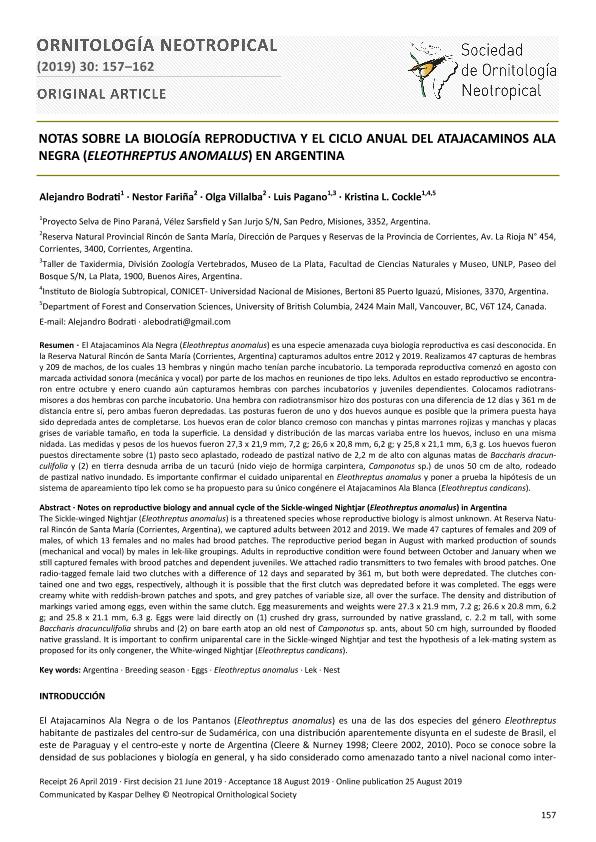Artículo
El Atajacaminos Ala Negra (Eleothreptus anomalus) es una especie amenazada cuya biología reproductiva es casi desconocida. En la Reserva Natural Rincón de Santa María (Corrientes, Argentina) capturamos adultos entre 2012 y 2019. Realizamos 47 capturas de hembras y 209 de machos, de los cuales 13 hembras y ningún macho tenían parche incubatorio. La temporada reproductiva comenzó en agosto con marcada actividad sonora (mecánica y vocal) por parte de los machos en reuniones de tipo leks. Adultos en estado reproductivo se encontraron entre octubre y enero cuando aún capturamos hembras con parches incubatorios y juveniles dependientes. Colocamos radiotransmisores a dos hembras con parche incubatorio. Una hembra con radiotransmisor hizo dos posturas con una diferencia de 12 días y 361 m de distancia entre sí, pero ambas fueron depredadas. Las posturas fueron de uno y dos huevos aunque es posible que la primera puesta haya sido depredada antes de completarse. Los huevos eran de color blanco cremoso con manchas y pintas marrones rojizas y manchas y placas grises de variable tamaño, en toda la superficie. La densidad y distribución de las marcas variaba entre los huevos, incluso en una misma nidada. Las medidas y pesos de los huevos fueron 27,3 x 21,9 mm, 7,2 g; 26,6 x 20,8 mm, 6,2 g; y 25,8 x 21,1 mm, 6,3 g. Los huevos fueron puestos directamente sobre (1) pasto seco aplastado, rodeado de pastizal nativo de 2,2 m de alto con algunas matas de Baccharis dracunculifolia y (2) en tierra desnuda arriba de un tacurú (nido viejo de hormiga carpintera, Camponotus sp.) de unos 50 cm de alto, rodeado de pastizal nativo inundado. Es importante confirmar el cuidado uniparental en Eleothreptus anomalus y poner a prueba la hipótesis de un sistema de apareamiento tipo lek como se ha propuesto para su único congénere el Atajacaminos Ala Blanca (Eleothreptus candicans). The Sickle-winged Nightjar (Eleothreptus anomalus) is a threatened species whose reproductive biology is almost unknown. At Reserva Natural Rincón de Santa María (Corrientes, Argentina), we captured adults between 2012 and 2019. We made 47 captures of females and 209 of males, of which 13 females and no males had brood patches. The reproductive period began in August with marked production of sounds (mechanical and vocal) by males in lek-like groupings. Adults in reproductive condition were found between October and January when we still captured females with brood patches and dependent juveniles. We attached radio transmitters to two females with brood patches. One radio-tagged female laid two clutches with a difference of 12 days and separated by 361 m, but both were depredated. The clutches contained one and two eggs, respectively, although it is possible that the first clutch was depredated before it was completed. The eggs were creamy white with reddish-brown patches and spots, and grey patches of variable size, all over the surface. The density and distribution of markings varied among eggs, even within the same clutch. Egg measurements and weights were 27.3 x 21.9 mm, 7.2 g; 26.6 x 20.8 mm, 6.2 g; and 25.8 x 21.1 mm, 6.3 g. Eggs were laid directly on (1) crushed dry grass, surrounded by native grassland, c. 2.2 m tall, with some Baccharis dracunculifolia shrubs and (2) on bare earth atop an old nest of Camponotus sp. ants, about 50 cm high, surrounded by flooded native grassland. It is important to confirm uniparental care in the Sickle-winged Nightjar and test the hypothesis of a lek-mating system as proposed for its only congener, the White-winged Nightjar (Eleothreptus candicans).
Notas sobre la biología reproductiva y el ciclo anual del atajacaminos ala negra (Eleothreptus Anomalus) en Argentina
Título:
Notes on reproductive biology and annual cycle of the Sickle-winged Nightjar (Eleothreptus anomalus) in Argentina
Fecha de publicación:
08/2019
Editorial:
Neotropical Ornithological Society
Revista:
Ornitología Neotropical
ISSN:
1075-4377
e-ISSN:
1075-4377
Idioma:
Español
Tipo de recurso:
Artículo publicado
Clasificación temática:
Resumen
Palabras clave:
ARGENTINA
,
BREEDING SEASON
,
EGGS
,
ELEOTHREPTUS ANOMALUS
,
LEK
,
NEST
Archivos asociados
Licencia
Identificadores
Colecciones
Articulos(IBS)
Articulos de INSTITUTO DE BIOLOGIA SUBTROPICAL
Articulos de INSTITUTO DE BIOLOGIA SUBTROPICAL
Citación
Bodrati, Alejandro; Fariña, Nestor; Villalba, Olga; Pagano, Luis; Cockle, Kristina Louise; Notas sobre la biología reproductiva y el ciclo anual del atajacaminos ala negra (Eleothreptus Anomalus) en Argentina; Neotropical Ornithological Society; Ornitología Neotropical; 30; 8-2019; 157-162
Compartir




